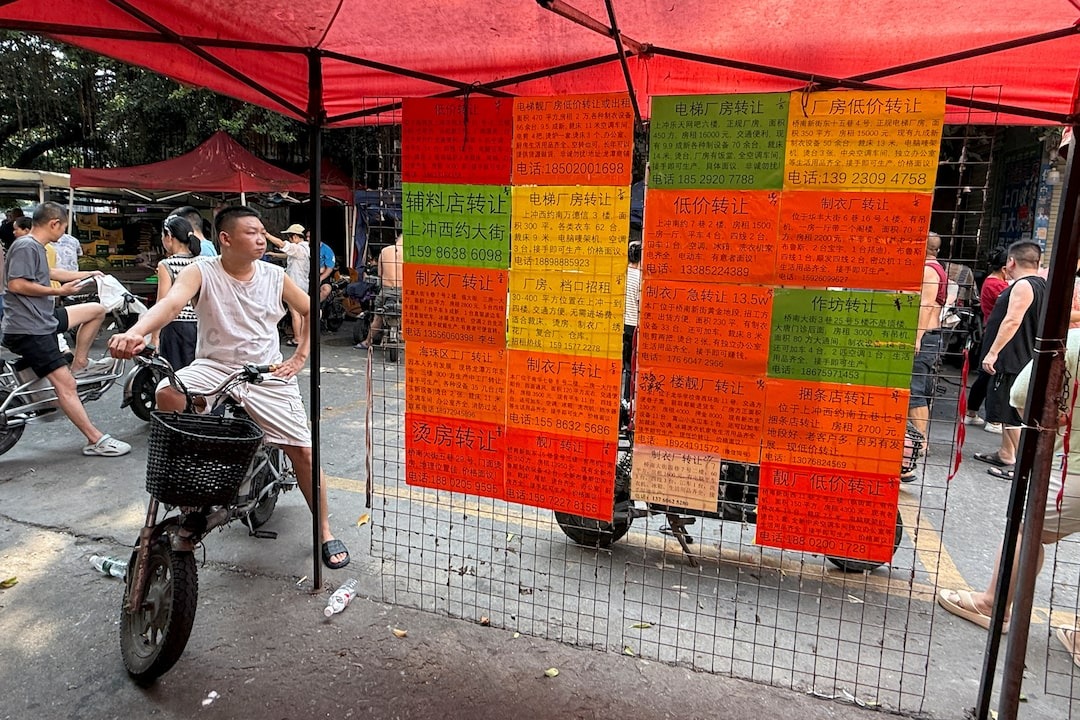"We are in survival mode," says 53-year-old Chai. He says his kitchen cabinet company, Cartia Global Manufacturing, is "barely breaking even."
When the pandemic hit, Chai cut his workforce in half, to about 100 employees. He can't cut any more. So, Chai started shortening shifts and encouraging unpaid leave.
"I told them, 'You don't want the factory to go bankrupt. You've been here for 10-15 years, so let's get through this together'," Chai recounts.
China's unemployment rate has held steady at around 5% this year, after former US President Donald Trump imposed additional 30% tariffs on Chinese goods. On 11/8/2024, he signed an order keeping those tariffs in place for another 90 days, preventing them from reverting to triple digits in April.
However, economists believe the true unemployment rate is worse due to the tariffs and industrial overproduction, which are driving down worker incomes. This is making them less confident about the future and less likely to spend. Consumer confidence in China is near record lows, retail sales are weakening, and inflation in July was near zero.
 |
A man reads factory notices in Guangdong in July. Photo: Reuters |
A man reads factory notices in Guangdong in July. Photo: Reuters
Alicia Garcia-Herrero, chief economist for Asia-Pacific at Natixis, says Chinese workers are suffering even as exports and the overall economy continue to grow despite US tariffs. "High competition and falling prices are forcing factories to cut costs, which means squeezing wages. It's a vicious cycle," she says.
Official statistics won't show Chinese workers "as the main victims" of the trade war because they aren't unemployed; they're just working fewer hours or taking unpaid leave.
Chai has lost two major clients in Australia after other Chinese companies lowered prices to compete. His factory is now operating at half capacity. "Companies leaving the US market are all turning to Australia. New supply is knocking on the doors of my customers," he laments.
China's exports to the US fell 21.7% in July. However, they rose 9.2% to Europe. Goods sold to Southeast Asia and Australia also increased by nearly 17% and 15%, respectively.
Chai wants to reduce prices by about 10%. To do this, he cut overtime from 28 days a month to 10. Overtime pay once accounted for more than one-third of his workers' income. On average, workers at Chai's factory earned 5,000 CNY (697 USD) before overtime.
Many other factory owners are switching to temporary workers. They hire when new orders come in and lay off workers when demand falls.
Dave Fong has three factories in southern China that produce a variety of products, from school backpacks to climbing gear and industrial machinery. He says he laid off 30 workers at each factory and then rehired them as temporary workers to complete sudden orders.
"We prefer temporary labor because we don't have to pay insurance, just daily or hourly wages," Fong explains. He says that if he didn't do this, the company would be pushed to the brink because consumer demand is falling and trade with the US is weakening.
Temporary labor is common in China. Chen Chuyan, a recruiter in Wuhan, says temporary worker wages have fallen from 16 CNY an hour last year to 14 CNY.
"Every day, there are long lines of people waiting to interview for jobs. But the factories don't have that much demand," Chen says.
Alan Zhang worked as a temporary worker at a garment factory in Guangzhou in 2021. He earned 400 CNY a day. But now, finding a job that pays half that is difficult.
"If it's only a few hundred CNY, I won't do it," the 30-year-old says after looking at handwritten job postings from brokers. "I don't understand what's happening. Things suddenly became difficult. Prices are falling too fast," Zhang says. He and his wife rent a studio apartment for 700 CNY a month.
Richard Yarrow, a fellow at the Mossavar-Rahmani Center at the Harvard Kennedy School, says that when manufacturing wages are squeezed, the overall economy faces deflationary pressure. "This is a growing concern for manufacturing industries that employ low-skilled labor in China, such as textiles, furniture, and simple electronics," he says.
At the Longhua job market in Shenzhen, dozens of people are reading job postings for electronics factories offering wages of 17-28 CNY per hour. Mo, 26, graduated with a degree in digital marketing but couldn't find a job in his field. He went on two interviews but rejected both because the actual conditions didn't match the advertisements. "They said the salary was 23 CNY, but in reality, they only paid 20," Mo explains.
Huang, 46, has been looking for work at this market for five consecutive days. He traveled from Yunnan by bus. Huang worked as a real estate project manager before the market crashed. Now divorced, he lives on 10 CNY meals and rents a dorm bed for 25 CNY a night.
"I had an interview this morning, but they asked for an 80 CNY referral fee. So, I didn't take it. I'd rather keep the money for food," Huang says.
Ha Thu (Reuters)












